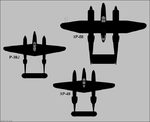machine shop tom
Senior Airman
- 504
- Apr 13, 2007
The Japanese had some promising designs that would have been interesting had they progressed. I'll not include the Shinden or the jet types to keep this post simple.
The Ki 100 was a successful adaptation of the Ki 61 "Tony" to use a radial engine. By all accounts a great performer.
The Ki 84 "Gale". Captured examples bested P-51s and P47s.
The N1K2KJ Shiden "George". Derived from a floatplane and a deadly adversary.
tom
The Ki 100 was a successful adaptation of the Ki 61 "Tony" to use a radial engine. By all accounts a great performer.
The Ki 84 "Gale". Captured examples bested P-51s and P47s.
The N1K2KJ Shiden "George". Derived from a floatplane and a deadly adversary.
tom



